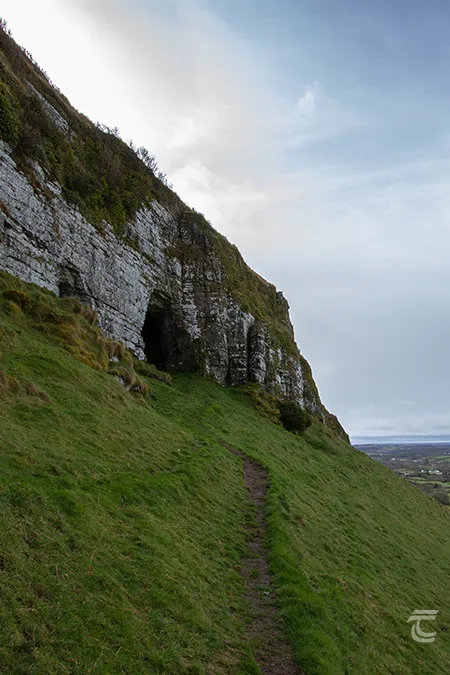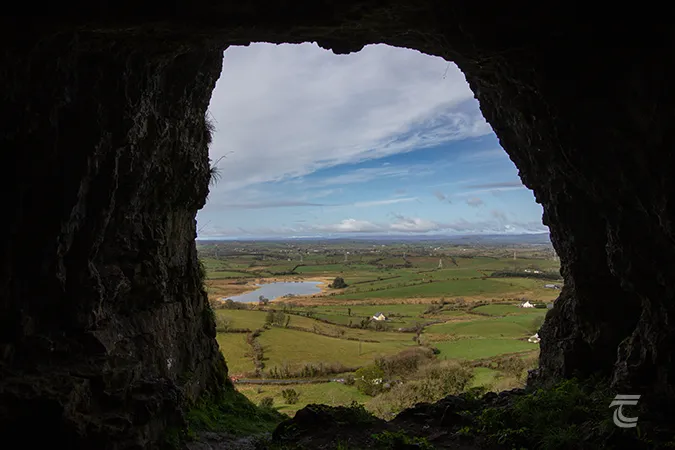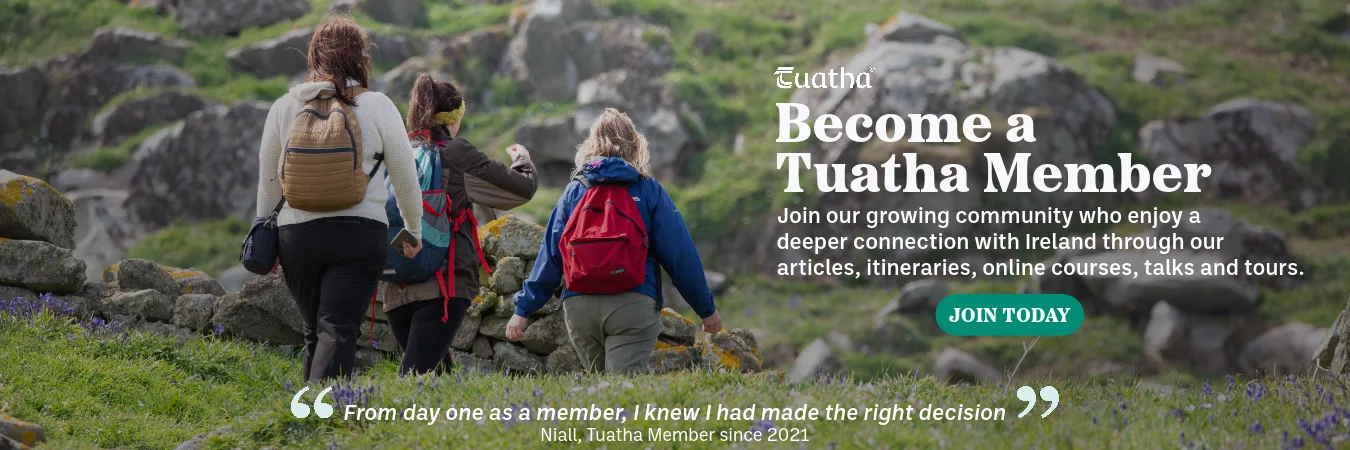Caves of Keash and Keshcorran Mountain
The Caves of Keash are some of Ireland’s most visually striking caves, appearing as black mouths set in the white limestone rock face of Keshcorran Mountain. There are 16 caves, and you can access a number of them. To an extent, all caves are evocative and atmospheric, and many are far more extensive and geologically awe-inspiring, but few cave systems in Ireland have the wealth of archaeology, mythology and folklore to compare with Sligo’s Caves of Keash. The caves are high on the western shoulder of Keshcorann, which along with Carrowkeel, is part of the Bricklieve karst limestone uplands in the south-east of County Sligo. The uplands are relatively low in height, with a maximum height of approximately 360m above sea level, but they form a dramatic landscape. Not only is it starkly beautiful, but it is one of Ireland’s richest archaeological landscapes. It has clearly been significant for millennia, with the passage tomb complex, nearly 150 hut sites, enclosures, court tombs and a plethora of other prehistoric features.
Keshcorran, like the near neighbours at Carrowkeel, is topped by a cairn, that is likely to be a Neolithic passage tomb that is part of the same extended upland cemetery. Other prominent Sligo passage tombs and tomb complexes, like Carrowkeel and Knocknarea, are also positioned close to caves. Archaeological evidence appears to suggest that the caves and cairns were part of a ritual complex in the Neolithic period. The caves appear to have been used as a place of excarnation, where the bodies of the deceased were left until they became skeletal. Then the bones were collected for later internment in the tomb.
For practical information about visiting this site Click Here

The Caves of Keash • Sligo
Surveys by archaeologist Tatjana Kytmannow has also identified a number of other features, including cist graves, a possible hut site, a section of pre-bog wall, a massive ‘megalithic’ wall structure and a wedge tomb. Tatjana also confirmed the presence of a large, pear-shaped enclosure formed by a low wall that is now largely covered by peat. The wall encompasses the cairn and appears to be more marking a sacred limit than anything defensive like a hillfort, as the enclosure does not utilise the natural defensive contours of the summit. Taken together, it is clear that Keshcorran has an interesting ritual complex, that spans a time-frame from the Neolithic into the Iron Age. The Caves of Keash located off the shoulder of the summit also have a long life span, with activity from many periods of Irish archaeology represented.
The Caves of Keash are identified by the letters A to P, from north to south. Cave J was named Coffey Cave and Cave P was named Plunkett Cave in honour of Thomas Plunkett, both of whom were involved in the first excavations. Some of the caves have more evocative names. Cave E is known as the ‘Hermit’s Bedroom’, a late 19th century account described how a hermit lived in the cave ‘some years ago’, but was trapped during a snowstorm and died of exposure and hunger.
Investigations in the caves during the early 20th century, discovered bones from animals that stalked Ireland towards the end of the Ice Age – with evidence of hares, brown bear, red deer, Arctic lemming and wolves all dating to more than c.12,000 years ago. Human activity has also been identified from many periods, with artefacts such as a Neolithic polished stone axe, a Bronze Age spearhead, early medieval comb fragments and other objects. As ever, it is the remains of the people themselves that tell the most intriguing stories, continue reading below to dig deeper into the Caves of Keash.

A view of the distant passage tomb cemetery at Carrowkeel from Keshcorran Mountain • Sligo
Archaeological Investigations at the Caves of Keash

Neil looking out from the mouth of Cave K • Caves of Keash
Curiously a number of human teeth were recovered during investigations at the Caves of Keash. They were found to date from different periods ranging from the Iron Age, to the Early Medieval period. These were the teeth of human adults, and due to the number of examples and nature of their deposition they are unlikely to be accidental losses. As there was no accompanying skeletal remains it is quite possible that they represent some kind of votive ritual tradition or religious practice. Animal teeth (particularly dog and horse) were also discovered in similar deposits. Both dogs and horses were highly prized and almost revered in Iron Age Ireland so they may also represent ritual activity. In her excellent The Archaeology of Caves in Ireland, Dr Marion Dowd suggests that is possible that the teeth formed part of a ritual celebrating Lughnasa, as the Keash Caves are particularly associated with the Iron Age god Lugh.
During the early medieval period, tentative evidence of a hearth along with animal and fish bones, comb fragments and needles, appears to suggest that at least two of the caves was used for habitation, at least temporarily. Intriguingly, the bone comb fragments appear to be Scandinavian in style. Could this be another case of the Vikings using caves, like at Dunmore Cave in Kilkenny, Cloghermore Cave in Kerry and the Alice and Gwendoline Caves, Clare?
Another discovery has more sinister possibilities. Part of a leg bone of an adult male was discovered within one of the caves, nearby to an iron crossbow bolt. This could represent the grisly end for someone who was hiding in the caves before they were hunted down. An entry in the Annals of the Four Masters from 1007 AD states:
‘…Muireadhach, a distinguished bishop…was suffocated in a cave, in Gaileanga of Corann.’

Neil looking out from the mouth of Cave K • Caves of Keash
Being so highly visible and unusual in the landscape, the Caves of Keash and the mountain are imbued with myth, legend and folklore. Cormac mac Airt, the legendary High King of Tara, was said to have been born by a well at the foot of Keshcorran, and was raised by a she-wolf in one of the caves. Perhaps an echo of the famous classical Roman story of Romulus and Remus who were also raised by a wolf in a cave. The caves also feature in stories of Fionn MacCumhaill, who had to enter the caves to seek out the otherworld smithy of Lon MacLíomhtha. Another story featuring the caves tells how Fionn and his Fianna were captured and bound in the caves by three hideous hags.
As a place of rich folklore and intriguing archaeology, stunning views and atmospheric aspects, a trip to the Caves of Keash is highly recommended!
Upper left: the cairn on the summit of Keshcorran • Lower left: the view from the mouth of Cave E (known as the Hermit’s Cave) • Right: the path to the caves
Top: the cairn on the summit of Keshcorran • Middle: the view from the mouth of Cave E (known as the Hermit’s Cave) • Bottom: the path to the caves
Caves of Keash Visitor Information
A place of rich folklore and intriguing archaeology, stunning views and atmospheric aspects – a real must see in County Sligo!
Explore more sites on the Wild Atlantic Way





